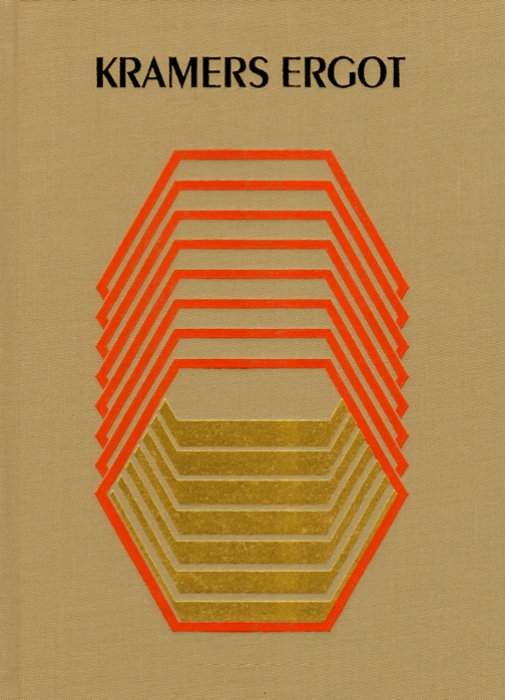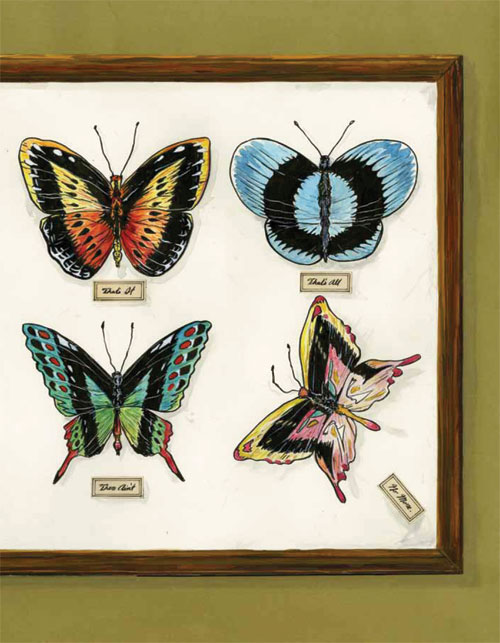Posts Tagged ‘Dash Shaw’
Comics Time: Kramers Ergot 8
January 18, 2012Kramers Ergot 8
Robert Beatty, Gabrielle Bell, Chris Cilla, Anya Davidson, Ron Embleton, C.F., Sammy Harkham, Tim Hensley, Kevin Huizenga, Ben Jones, Frederic Mullalley, Takeshi Murata, Gary Panter, Johnny Ryan, Leon Sadler, Frank Santoro, Dash Shaw, Ian Svenonius, writers/artists
Sammy Harkham, editor
PictureBox, January 2012
232 pages, hardcover
$32.95
Buy it from PictureBox
Buy it from Amazon.com
For today’s Comics Time review, please visit The Comics Journal.
Comics Time: Mome Vol. 22: Fall 2011
December 20, 2011Mome Vol. 22: Fall 2011
Zak Sally, Kurt Wolfgang, Jordan Crane, Chuck Forsman, Steven Weissman, Sara Edward-Corbett, Laura Park, Tom Kaczynski, Joe Kimball, Jesse Moynihan, Josh Simmons, The Partridge in the Pear Tree, Malachi Ward, Eleanor Davis, James Romberger, Derek Van Gieson, Michael Jada, Tim Lane, Nate Neal, Wendy Chin, Anders Nilsen, Tim Hensley, Lilli Carré, T. Edward Bak, Nick Drnaso, Joseph Lambert, Paul Hornschemeier, Sergio Ponchione, Nick Thorburn, Dash Shaw, Ted Stearn, Jim Rugg, Victor Kerlow, Noah Van Sciver, Gabrielle Bell, writers/artists
Eric Reynolds, editor
Fantagraphics, 2011
240 pages
$19.99
Buy it from Fantagraphics
Buy it from Amazon.com
For today’s Comics Time review, please visit The Comics Journal.
Comics Time: Mome Vol. 21: Winter 2011
December 16, 2011Mome Vol. 21: Winter 2011
Sergio Ponchione, The Partridge in the Pear Tree, Josh Simmons, Dash Shaw, Steven Weissman, Kurt Wolfgang, Sara Edward-Corbett, Nicolas Mahler, Tom Kaczynski,
Josh Simmons, Jon Adams, Nate Neal, T. Edward Bak, Michael Jada, Derek Van Gieson, Nick Thorburn, Lilli Carré, writers/artists
Eric Reynolds, editor
Fantagraphics, 2011
112 pages
$14.99
Buy it from Fantagraphics
Buy it from Amazon.com
It was the best of Momes, it was the worst of Momes. Alright, that’s not quite accurate, and not quite fair, either. But this unwittingly penultimate issue of Fantagraphics’ long-running alternative-comics anthology — page for page the longest-running such enterprise in American history! — is a hit-or-miss affair in the mighty Mome manner. In the miss column you can place Sergio Ponchione’s bombastic, cartoony fantasy about an imaginary childhood friend brought to life; there’s really not much more to it than that description would indicate. Ditto Kurt Wolfgang’s next “Nothing Eve” chapter, which continues to work the “people still act pretty much the same even though the end of the world is coming” buttons it’s been mashing since issue #1. T. Edward Bak’s “Wild Man” remains awkwardly paced due to its split-up narrative captions; Nicolas Mahler’s autobio strip remains of limited interest to people not Nicolas Mahler; Lilli Carré’s contribution is nicely colored in reds and blues but otherwise insubstantial.
A few contributions are both hit and miss at once. Sara Edward-Corbett’s near-wordless reverie involving inanimate objects romping around the outside of a house comes across more inscrutable than mysterious, but at the same time her crosshatching and linework are an absolute marvel, and she’s playing with forms (and with form) in a fashion reminiscent of John Hankiewicz, if not as successful. Steven Weissman’s deadpan “Barack Hussein Obama” strips fall flat when they merely parody the rhythms of four-panel gag comics, but spring to surreal and oddly scathing life when he injects a healthy dose of the sinister supernatural into them. I’ve never quite cottoned to the way Jon Adams’s razor-thin line and labored-over character renderings sit against the large white expanses of his pages, and his writing feels overwrought to me, but he does give his blackly humorous tale of a hunting expedition gone bad a laugh-out-loud visual punchline. And Nate Neal’s caveman morality play makes much better use of his meaty cartooning than his lukewarm slice-of-lifers do, though the conceit of gibberish dialogue from the cavepeople conceals more than it illuminates.
So that leaves the hits, and they’re strong enough to make the book worth checking out. Dash Shaw continues his seemingly ongoing series of adaptations of “reality” programming, this time an excerpt from a making-of documentary about Jurassic Park; he has a really sharp and off-kilter eye for people observing and commenting on their own behavior for a camera, and his transition from talking heads to full documentary “footage” is a gleeful one. Nick Thorburn’s take on Benjamin Franklin, a first-person monologue in which Ben lets us in on a dirty little secret, is anachronistically absurd (“In Seventeen-Sumthin’-Er-Other, right before I invented electricity and just after I’d sired my illegitimate son, I received an e-mail from Lord Sandwich about comin’ to London to take part in this new secret society known as ‘The Hellfire Club.'”) and very funny, with a great undergroundy character design for Franklin himself. Derek Van Gieson’s murky World War II period piece continues to stun from page to page. Tom Kaczynski examines home ownership during terminal-stage capitalism as only he can, casting it as a catalyst for powerful erotic and apocalyptic impulses and proving himself once again to be one of the most stealthily sexy cartoonists working today. “Stealthy” isn’t a word I’d use for Josh Simmons, but he doesn’t need it: His weird psychedelic fantasia on racism “The White Rhinoceros” is as bold and bulldozing as the giant slugs who stampede across its pages, and the elliptically concluded short story “Mutant” ends with an image of an enraged creature in the form of a human female, her nude body shadowed but covered in glistening sweat, that may as well symbolize the workings of Simmons’s entire brain. You gotta take the rough to find the diamonds.
Comics Time: Bodyworld
January 12, 2011Bodyworld
Dash Shaw, writer/artist
Pantheon, April 2010
384 pages, hardcover
$27.95
Read it for free at DashShaw.com
Buy it from Amazon.com
Did everyone know this was a comedy but me? I actually put off reading Dash Shaw’s, what is it now, second magnum opus and first full-length science-fiction graphic novel because I find the formal experimentation of his SF stuff intimidatingly difficult to parse even in short-story format — surely a 400-page webcomic turned fat hardcover would fuck my shit up, right? But while Shaw’s shorts frequently swap complexity for clarity, at least for me, Bodyworld is a breeze to read. Part of that’s physical — the fun of its vertical layout, kicking back and flipping the pages upward on your lap or desk. But mostly it’s that the thing reads like a quirky indie-movie genre-comedy — think a mid-00s Charlie Kaufman joint, or Duncan Jones’s Moon with more laffs ‘n’ sex. We follow one helluva protagonist, Professor Paulie Panther, a cigarette-smoking, plain white tee-clad schmuck who wouldn’t look out of place hanging out with Ray D. and Doyle in a Jaime Hernandez comic and who has harnessed his prodigious appetite for doing drugs and not doing work into a career as a field-tester for hallucinogenic plants. Basically, he travels around the world smoking anything that looks unusual. For the purposes of Bodyworld that has taken him to Boney Borough, a Thoreau-like enclave whose planners mixed unfettered nature right into the zoning laws as a response to a horrific decades-long Second Civil War that began ravaging the United States, it seems, following the installation of George W. Bush. There he discovers a smokable plant that gives its users a telepathic bond with anyone in their proximity, leading to disastrous romantic entanglements and disentanglements with the local high school’s hot teacher, its prom king, and his girlfriend. But there’s more to the plant that meets the eye, and a Repo Man-style series of surreal/slapstick/science-fictional escalations leads to a funny but still black and potentially apocalyptic ending, like the Broadway version of Little Shop of Horrors.
Bodyworld‘s webcomic incarnation was famous for its vertical scroll, and for my money it’s recreated enjoyably by the vertical flip in the book format. What surprised me about Shaw’s other formal innovations here is how relatively restrained they are. You don’t really need to keep track of his complex, color-coded grid maps of Boney Borough or the school to understand what’s going on where, and the to the extent that he plays with overlaps and repetition and color and so on it’s mostly done to convey the hallucinogenic mind-melding engendered by the drug, quite effectively, at that. Moreover, I’ve often found his character designs hard to parse and hard to like — something about the way they’re constructed from purposely ugly swirls and swoops just gives me prosopagnosia — but his quartet of leads and dozen or so prominent supporting characters are by far his strongest ever in this area; you really can get who they are and what they’re about just by looking at them, which prospect is not at all unpleasant, either. And while some of the yuks fall flat (particularly with the town sheriff late in the game), it’s for the most part a dryly witty, occasionally laugh-out-loud funny comedy, with finely observed humor about high schoolers, teachers, druggies, hoary sci-fi tropes, and the sort of shiftless ne’er-do-wells you enjoy spending an evening with when your buddy brings them along. In short, it’s a prodigiously ambitious cartoonist plying the various tricks of his trade just to tell a good story you can catch some weekend afternoon and then chat about with friends at the diner afterwards.




